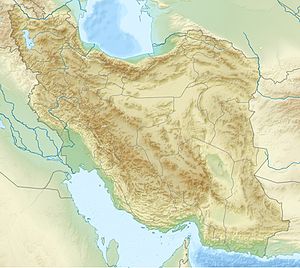Teppe Zagheh
تپه زاغه | |
 Tepe Zagheh mortar, c.7000 BC | |
 Shown within Near East | |
| Alternative name | Tappeh Sang-e Chakhmaq, Sange Chaxmaq, Chakhmagh |
|---|---|
| Location | Iran |
| Coordinates | 35°46′48″N 49°56′23″E / 35.7800°N 49.9397°ECoordinates: 35°46′48″N 49°56′23″E / 35.7800°N 49.9397°E |
| Type | Neolithic archaeological site |
| Site notes | |
| Excavation dates | 1969 |
| Archaeologists | Seiichi Masuda |
Teppe Zagheh (Persian: تپه زاغه) is an early urban settlement located near Qazvin, Iran. In Persian, teppe means "tell, hill".
Settlement[]
The settlement has been dated to have been built in 6500 BCE.
After the re-excavation of Zagheh in 2001, new radiocarbon dates were obtained. They indicate that the site was settled c. 5370–5070 BC and abandoned c. 4460–4240 BC. Thus, it may belong to only a single historical period, Transitional Chalcolithic.[1][2]

Yet there were also many small clay 'tokens', used as counting objects, that were found at Zagheh; these are variously-shaped, and are similar to such tokens at other Neolithic sites. These Zagheh tokens are dated typologically to 6500–5500 BC.[3] Thus, there were probably two periods of occupation.
Zagheh archaic painted ware (ca. 6000-5500 BC) was found in Tepe Sialk I, sub-levels 1-2. This is the early painted ware, that was first excavated at Teppe Zagheh.[4]
Clay figurines found in Mehrgarh (Pakistan), an important precursor to the Indus Valley Civilization, resemble those discovered at Teppe Zagheh, and at Jeitun in Turkmenistan (6th millennium BCE).[5]
Relative chronology[]
Notes[]
- ^ FAZELI NASHLI, H., E.H. WONG & D.T. POTTS. 2005. The Qazvin Plain revisited: a reappraisal of the chronology of the north western Central Plateau, Iran, in the 6th to the 4th millennium BC. Ancient Near Eastern Studies 42: 3–82
- ^ Hassan Fazeli Nashli & Niloufar Moghimi (2013), Counting objects: new evidence from Tepe Zagheh, Qazvin plain, Iran. Antiquity Journal
- ^ Hassan Fazeli Nashli & Niloufar Moghimi (2013), Counting objects: new evidence from Tepe Zagheh, Qazvin plain, Iran. Antiquity Journal
- ^ Robert H. Dyson (2011), CERAMICS: The Neolithic Period through the Bronze Age in Northeastern and North-central Persia. iranicaonline.org
- ^ Jarrige C (2008) The figurines of the first farmers at Mehrgarh and their offshoots. Pragdhara 18: 155–166
References[]
- Sabk Shenasi Mi'mari Irani (Study of styles in Iranian architecture), M. Karim Pirnia. 2005. ISBN 964-96113-2-0
See also[]
- Populated places established in the 7th millennium BC
- Populated places disestablished in the 5th millennium BC
- Tells (archaeology)
- Architecture of Iran
- Archaeological sites in Iran
- Prehistoric Iran
- National works of Iran

